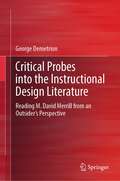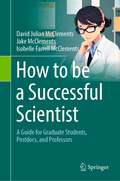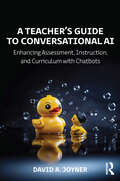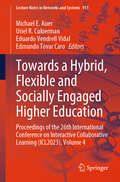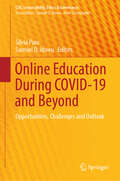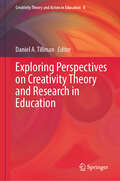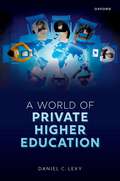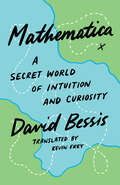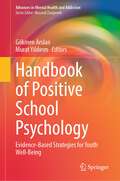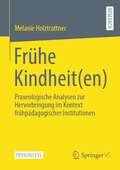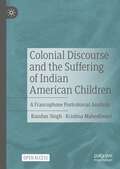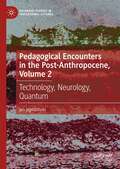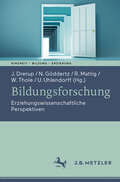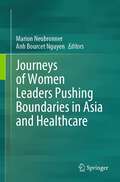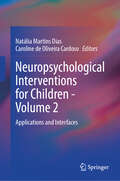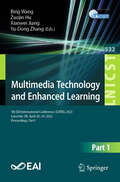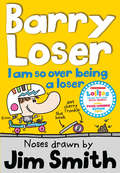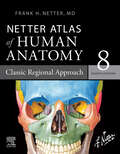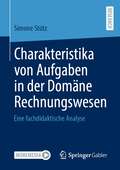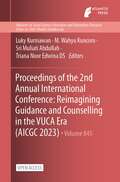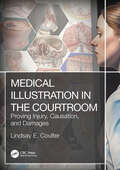- Table View
- List View
Critical Probes into the Instructional Design Literature: Reading M. David Merrill from an Outsider’s Perspective
by George DemetrionThis book provides a comprehensive study of the work of M. David Merrill, a major pioneer in the field of instructional design. This book centers on his research on his second generation instructional design (ID2) theory, Instructional Transaction Theory, and First Principles of Instruction, which has had a substantial impact on the instructional design field. It’s appealing to the instructional design research and practitioner-based communities who can draw on specific sections of this book to enhance their own work. It is also intended for those seeking to learn more about the relationship between the instructional design field, learning theory, curriculum studies, and lifelong learning/adult education studies. Through this critical, yet empathetic study of Merrill’s 50+ year research agenda, this book provides an illuminating field of entry into a broad range of topics, both those that are central to Merrill’s own research agenda, and into areas that extend well beyond his essentially cognitivist epistemological assumptions.
How to be a Successful Scientist: A Guide for Graduate Students, Postdocs, and Professors
by David Julian McClements Jake McClements Isobelle Farrell McClementsThis book provides important advice to scientists at all stages of their careers on how to be a more effective and impactful researcher. It provides tips on: designing, performing, and analyzing experiments; writing, submitting and revising manuscripts; preparing and giving scientific talks and posters; writing grant proposals; and writing and defending a graduate thesis. It also provides advice on soft skills, like communication, networking, creativity, critical thinking, and working in teams. A major emphasis of the book is the importance of writing and publishing scientific manuscripts, as this is the main way that scientific knowledge is disseminated, as well as being an important element for building a strong curriculum vitae. The book should be an extremely valuable resource for graduate students throughout their studies but should also be useful for postdocs and professors who want to hone their research skills. The book is written by three scientists from the same family who are each at different stages in their careers and can therefore provide different perspectives. David Julian McClements is a distinguished professor who is currently the most highly cited author in Food Science in the world. He has published over 1300 scientific articles and numerous books. Jake McClements is beginning his career as a lecturer in the United Kingdom, while Isobelle Farrell McClements is just starting her career as a graduate student in the United States.
A Teacher’s Guide to Conversational AI: Enhancing Assessment, Instruction, and Curriculum with Chatbots
by David A. JoynerA Teacher’s Guide to Conversational AI explores the practical role that language-based artificial intelligence tools play in classroom teaching, learning experiences, and student assessment. Today’s educators are well aware that conversational and generative AI—chatbots, intelligent tutoring systems, large language models, and more—represent a complex new factor in teaching and learning. This introductory primer offers comprehensive, novice-friendly guidance into the challenges and opportunities of incorporating AI into K-12 schools and college classes in ways that are appropriate, nourishing to students, and outcomes-driven.Opening with an informative overview of the foundational properties, key terminology, and ethical considerations of these tools, the book offers a coherent and realistic vision of classrooms that are enhanced, rather than stymied, by AI systems. This includes strategies for:· designing assessments that are conducive to students’ beneficial use of AI while mitigating overreliance or dishonesty;· using AI to generate lesson examples for student critique or custom content that reinforces course principles;· leveraging chatbots as a co-instructor or a tutor, a guide during student-driven learning, a virtual debate or brainstorming partner, and a design project; and· creating course content, lesson plans and activities, expanded language and accessibility options, and beyond. Through the depth of understanding and applied approach provided in these chapters, teachers and leaders in training and in service, alongside private tutors, college instructors, and other educators, will be better prepared to future-proof their efforts to serve new generations of learners.
A Teacher’s Guide to Conversational AI: Enhancing Assessment, Instruction, and Curriculum with Chatbots
by David A. JoynerA Teacher’s Guide to Conversational AI explores the practical role that language-based artificial intelligence tools play in classroom teaching, learning experiences, and student assessment. Today’s educators are well aware that conversational and generative AI—chatbots, intelligent tutoring systems, large language models, and more—represent a complex new factor in teaching and learning. This introductory primer offers comprehensive, novice-friendly guidance into the challenges and opportunities of incorporating AI into K-12 schools and college classes in ways that are appropriate, nourishing to students, and outcomes-driven.Opening with an informative overview of the foundational properties, key terminology, and ethical considerations of these tools, the book offers a coherent and realistic vision of classrooms that are enhanced, rather than stymied, by AI systems. This includes strategies for:· designing assessments that are conducive to students’ beneficial use of AI while mitigating overreliance or dishonesty;· using AI to generate lesson examples for student critique or custom content that reinforces course principles;· leveraging chatbots as a co-instructor or a tutor, a guide during student-driven learning, a virtual debate or brainstorming partner, and a design project; and· creating course content, lesson plans and activities, expanded language and accessibility options, and beyond. Through the depth of understanding and applied approach provided in these chapters, teachers and leaders in training and in service, alongside private tutors, college instructors, and other educators, will be better prepared to future-proof their efforts to serve new generations of learners.
Towards a Hybrid, Flexible and Socially Engaged Higher Education: Proceedings of the 26th International Conference on Interactive Collaborative Learning (ICL2023), Volume 4 (Lecture Notes in Networks and Systems #911)
by Michael E. Auer Uriel R. Cukierman Eduardo Vendrell Vidal Edmundo Tovar CaroWe are currently witnessing a significant transformation in the development of education on all levels and especially in post-secondary education. To face these challenges, higher education must find innovative and effective ways to respond in a proper way. The pandemic period left us with profound changes in the way we teach and learn, including the massive use of new means of communication, such as videoconferencing and other technological tools. Moreover, the current explosion of artificial intelligence tools, mainly used by students, is challenging teaching practices maintained for centuries. Scientifically based statements as well as excellent best practice examples are absolutely necessary.The 26th International Conference on Interactive Collaborative Learning (ICL2023), which will take place in Madrid, Spain, between 26th and 30th September 2023, will be the perfect place where to present and discuss current trends in Higher Education.Since its beginning in 1998 this conference is devoted to new approaches in learning with a focus on collaborative learning in Higher Education. Nowadays the ICL conferences are a forum of the exchange of relevant trends and research results as well as the presentation of practical experiences in Learning and Engineering Pedagogy. In this way we try to bridge the gap between ‘pure’ scientific research and the everyday work of educators.
Online Education During COVID-19 and Beyond: Opportunities, Challenges and Outlook (CSR, Sustainability, Ethics & Governance)
by Samuel O. Idowu Silvia PuiuThis book aims to provide sustainable solutions for better understanding and management of online education in different parts of the world. In this context, it explores the attitudes and perceptions of stakeholders, such as students, faculty, and other actors on issues related to online education. In particular, it examines the challenges they have faced over the years when online courses were introduced due to the COVID-19 pandemic. A model is proposed that includes five variables: specific communication issues in online education, the ability of professors to offer online courses, the quality of online education, students' perceived stress during online education, and the technical requirements of online education.The book will be of interest to anyone concerned with the new and future ways of teaching and learning.Chapter “When a Phenomenon-Based University Course Went Online: Students’ Experiences and Reflections After Sauna Bathing” is available open access under a Creative Commons Attribution 4.0 International License via link.springer.com.
Exploring Perspectives on Creativity Theory and Research in Education (Creativity Theory and Action in Education #8)
by Daniel A. TillmanCollectively, the sixteen chapters in this book investigate the power of creativity in the classroom, many through the specific lens of limited resources as an opportunity. The chapters are divided into two sections, eight chapters comprising Section I: Theory and Research and then the eight chapters comprising Section II: Additional Perspectives and Future Directions. Within these two sections, the more than two-dozen authors that contributed to this book tackle a wide range of the possibilities for designing creative classroom-based instruction wherein limited resources are highlighted and valued, rather than avoided or lamented. The two main sections of this book are each preceded by a brief introductory summary highlighting those sections’ attributes and objectives, with the intention of providing helpful structure to the reader—but the book has also been designed such that each chapter stands independently and can be jumped to directly like a handbook. In its totality, this book exploring perspectives on creativity theory and research in education is designed to serve as a valuable resource for teachers, teacher educators, school administrators, parents, and education researchers, along with anyone else that is interested in optimizing our opportunities for nurturing creativity within classrooms.
A World of Private Higher Education
by Daniel C. LevyA World of Private Higher Education is the definitive treatment of a sector accounting for a third of the world's 200 million higher education enrolment--yet remaining largely unknown even to scholars of higher education and widely mis-characterized when it is considered by stakeholders or the general public. Beyond the eye-popping numbers, several inter-related thematic findings regarding the Private and the Public underscore the subject matter's importance. First, private-public differences are significant-it matters that so many students are in a sector that not long ago was only marginal in much of the world. Second, private higher education (PHE) itself is increasingly diverse, with significant and private-private differences. Third, the overlaying of the first two realities yields increasing diversity in private-public higher education distinctions. Especially for its pioneering mapping of PHE globally, regionally, and nationally, the book draws on the pioneering dataset of the pioneering scholarly program for research on PHE (Program for Research on Private Higher Education). Unprecedented in geographical scope, the dataset is unprecedented in longitudinal coverage too, dating back to 2000. Empirical methods allow for extensive analysis, and theoretical analysis draws on key private-public concepts embedded in literatures on privatization, nonprofit studies, and policy models. For the major challenge of penetrating inside the increasingly diverse private sector of higher education, Levy revises his heralded and widely employed PHE typology.
A World of Private Higher Education
by Daniel C. LevyA World of Private Higher Education is the definitive treatment of a sector accounting for a third of the world's 200 million higher education enrolment--yet remaining largely unknown even to scholars of higher education and widely mis-characterized when it is considered by stakeholders or the general public. Beyond the eye-popping numbers, several inter-related thematic findings regarding the Private and the Public underscore the subject matter's importance. First, private-public differences are significant-it matters that so many students are in a sector that not long ago was only marginal in much of the world. Second, private higher education (PHE) itself is increasingly diverse, with significant and private-private differences. Third, the overlaying of the first two realities yields increasing diversity in private-public higher education distinctions. Especially for its pioneering mapping of PHE globally, regionally, and nationally, the book draws on the pioneering dataset of the pioneering scholarly program for research on PHE (Program for Research on Private Higher Education). Unprecedented in geographical scope, the dataset is unprecedented in longitudinal coverage too, dating back to 2000. Empirical methods allow for extensive analysis, and theoretical analysis draws on key private-public concepts embedded in literatures on privatization, nonprofit studies, and policy models. For the major challenge of penetrating inside the increasingly diverse private sector of higher education, Levy revises his heralded and widely employed PHE typology.
Mathematica: A Secret World of Intuition and Curiosity
by David BessisA fascinating look into how the transformative joys of mathematical experience are available to everyone, not just specialists Math has a reputation for being inaccessible. People think that it requires a special gift or that comprehension is a matter of genes. Yet the greatest mathematicians throughout history, from René Descartes to Alexander Grothendieck, have insisted that this is not the case. Like Albert Einstein, who famously claimed to have “no special talent,” they said that they had accomplished what they did using ordinary human doubts, weaknesses, curiosity, and imagination. David Bessis guides us on an illuminating path toward deeper mathematical comprehension, reconnecting us with the mental plasticity we experienced as children. With simple, concrete examples, Bessis shows how mathematical comprehension is integral to the great learning milestones of life, such as learning to see, to speak, to walk, and to eat with a spoon. Focusing on the deeply human roots of mathematics, Bessis dispels the myths of mathematical genius. He offers an engaging initiation into the experience of math not as a series of discouragingly incomprehensible logic problems but as a physical activity akin to yoga, meditation, or a martial art. This perspective will change the way you think not only about math but also about intelligence, intuition, and everything that goes on inside your head.
Handbook of Positive School Psychology: Evidence-Based Strategies for Youth Well-Being (Advances in Mental Health and Addiction)
by Gökmen Arslan Murat YıldırımStudents spend significantly more time in school compared to any other formal institution during their lives; therefore, mental health in schools has attracted a lot of attention in recent years. According to Seligman et al. (2009), positive psychology in school is a response to the gap between what people want for their children and what schools teach. That is, most parents want their children to be happy, healthy, and confident, but schools only focus on achievement, discipline, and academic skills. These are of course important, but so are positive mental health outcomes. To fix this gap, schools must teach achievement and accomplishment along with positive psychology-informed mental health skills. In other words, positive education aims to bring positive psychology’s goals of well-being and mental health support for everyone into the school setting.Psychological interventions have been around in schools since at least the 1930s. Therefore, it makes sense to supplement the already-existing traditional psychology in schools with positive psychology. In the field of psychology, positive psychology interventions are defined as those aimed at raising positive feelings, positive thoughts, and positive behaviour and increasing well-being. Positive Psychology Interventions in schools have been shown to improve mental health and well-being outcomes for students. Recent research has confirmed the same results, as offering emotional support early in a school year can lead to improved instructional quality later in that school year. In other words, positive school psychology interventions offer a focus on mental health in order to set the stage and give students the opportunity for academic achievement. Since the beginning of the positive psychology movement, the application of its assumptions in schools has been one of the movement’s main pillars. The objective of the book is to help counsellors, teachers, and school leaders engage in a positive psychology research-based practice in schools.
Frühe Kindheit(en): Praxeologische Analysen zur Hervorbringung im Kontext frühpädagogischer Institutionen
by Melanie HolztrattnerIn diesem Open-Access-Buch nähert sich Melanie Holztrattner aus einer praxeologischen Perspektive der Frage, wie frühe Kindheit in frühpädagogischen Institutionen hervorgebracht wird. Aktuelle Diskurse der childhood studies aufgreifend wird Kindheit als in generationaler Ordnung (re)produziertes, historisch-kulturell gerahmtes und zugleich normativ-realitätsmächtiges Konstrukt verhandelt. Um sich der Frage nach der Hervorbringung früher Kindheit empirisch zu nähern, wurden ethnografische Feldaufenthalte in frühpädagogischen Institutionen in Österreich durchgeführt, wobei insbesondere die teilnehmenden Beobachtungen einen Zugang zu den Praktiken der Akteur*innen gewährten. Ausgewählte Feldprotokolle wurden mittels Dokumentarischer Methode rekonstruktiv analysiert. Die generierte relationale agency-Typologie bietet ein Deutungsangebot, frühe Kindheit als eine von Kindern und Fachkräften gemeinschaftlich hervorgebrachte Leistung vor dem Hintergrund komplexer Ordnungen zu verstehen. IndemHandlungs-, Entscheidungs- und Deutungsmacht in den Praktiken der Akteur*innen auf unterschiedliche Weise zu- oder abgesprochen und dabei Anerkennung auf unterschiedliche Weise (un)erlebbar wird, erfährt auch (kindliche) agency unterschiedliche Möglichkeiten der Beförderung und Begrenzung. Frühe Kindheit kann vor diesem Hintergrund auf plurale Weise in frühpädagogischen Institutionen hervorgebracht werden.
Colonial Discourse and the Suffering of Indian American Children: A Francophone Postcolonial Analysis
by Kundan Singh Krishna MaheshwariEuro-American misrepresentations of the non-West in general, and in particular on Hinduism and ancient India, run deep and have far greater colonial connections than that have been exposed in academia. This book analyzes the psycho-social consequences that Indian American children face after they are exposed to the school textbook discourse on Hinduism and ancient India. The authors show that there is an intimate connection—an almost exact correspondence—between James Mill’s colonial-racist discourse and the current school-textbook discourse. The very parameters and coordinates on which James Mill constructed the discourse are the ones that are being used to describe Hinduism, Hindus, and ancient India in the textbooks currently. Consequently, this archaic and racist discourse, camouflaged under the cover of political correctness, produces in the Indian American children a psychological impact quite similar to what racism is known to produce: shame, inferiority, embarrassment, identity confusion, assimilation, and a phenomenon similar to racelessness where the children dissociate from the tradition and culture of their ancestors. This book argues that the current school textbook discourse on Hinduism and India needs to change so that the Indian American children do not become victims of overt and covert racism. For the change to occur, the first step is to recognize the overarching and pervasive influence of the colonial-racist discourse of James Mill on the textbooks. For the reconstruction of the discourse to take place, the first step is to engage in a thorough deconstruction, which is what the book attempts.
Pedagogical Encounters in the Post-Anthropocene, Volume 2: Technology, Neurology, Quantum (Palgrave Studies in Educational Futures)
by jan jagodzinskiAs a follow up to Pedagogical Encounters in the Post-Anthropocene, Volume I, this book addresses three major areas in response to the post-Anthropocene: Technology, Neurology, Quantum. Each of these areas is broadly addressed in relation to the concerns that have arisen both theoretically and educationally. As in Volume I, the author terms these to be encounters as each area presents a particular problematic when addressing the phase change that the planet is undergoing where the anthropogenic labour of global humanity is contributing to climate change, endangering our very existence. Technology in education has been a significant development. There is a concerted effort to review this development placing stress on the rise of learning machines and algorithms. In the second encounter the vast literature on neurology is addressed, especially neurodiversity and the various symptoms that have emerged in the post-Anthropocene era. The last section reviews issues related to quantum theory as this is fundamental to tensions between physics and metaphysics. The volume concludes with the author’s own pedagogical proposal for the future.
Bildungsforschung: Erziehungswissenschaftliche Perspektiven (Kindheit – Bildung – Erziehung. Philosophische Perspektiven)
by Johannes Drerup Werner Thole Nina Göddertz Ruprecht Mattig Uwe UhlendorffDer Begriff ‚Bildungsforschung‘ erweist sich als nicht minder umstritten als der Begriff der Bildung selbst. Bildungsforschung fungiert in der Diskussion häufig als eine Art Regenschirmbegriff, mit dem ein Forschungsprofil markiert wird, das es ermöglichen soll, schulische, insbesondere unterrichtsbezogene Bildungsprozesse empirisch zu erfassen und von Schüler*innen zu erwerbende Kompetenzen festzulegen und mit Hilfe quantitativer Verfahren zu evaluieren. Im Rahmen von anderen Forschungstraditionen geht man auf kritische Distanz zu diesem inhaltlich und methodisch allzu sehr eingeschränkten Verständnis von Bildungsforschung. Im Zentrum des Bandes stehen erziehungswissenschaftliche Zugänge und Beiträge zur Bildungsforschung und damit verbundene disziplinäre Perspektiven und forschungsmethodologische Fragestellungen.
Journeys of Women Leaders Pushing Boundaries in Asia and Healthcare
by Marion Neubronner Anh Bourcet NguyenThis book brings together a collective of Women Leaders in Healthcare to share their real-life leadership journey in the Asian continent, from a personal angle (heart) and grounded on science (data). They are connected by a strong passion to help improve patient lives and advance women’s leadership in this dynamic, emerging region of Asia, still swaying between tradition and modernity. This is not an academic book but a compendium of inspirational stories meant to provide authentic and pragmatic guidance for women who want to advance their careers in healthcare in Asia, to reduce gender inequality and give a new meaning to the leadership of tomorrow, truly inclusive and diverse.Beyond gender, aspiring leaders can find inspiration from this compendium to succeed in the Asia context, from Japan to India, South East Asia and the Middle East. Although the challenges shared were experienced by the women-authors from diverse backgrounds and leadership, women and men alike can relate to many of the topics covered in the book. The resulting reflections can help the readers more efficiently climb the corporate ladder and become better leaders, to shape a more equitable future. This book provides insights for organizations in their diversity, equity and inclusion endeavors, to develop policies that foster talents in Asia and provide better support to women in leadership positions. It is also a useful read for students and researchers of leadership and gender studies.
Neuropsychological Interventions for Children - Volume 2: Applications and Interfaces
by Caroline de Oliveira Cardoso Natália Martins DiasThis book is the second of two volumes that aim to serve as a comprehensive guide for professionals working with neuropsychological interventions especially designed for children. This second volume complements the theoretical and practical foundations presented in the first volume by presenting applications to different clinical conditions and by exploring interfaces of neuropsychology with other areas of research and practice. Chapters in this second volume are divided into two parts. The first part presents a series of case studies, illustrating the practice and experience of neuropsychological rehabilitation and habilitation in different clinical conditions. The second part brings together chapters that discuss the interfaces of neuropsychology with different areas, which can use its knowledge and interventions (such as school neuropsychology) or which can be used as strategies within neuropsychological intervention or even compose inter and transdisciplinary partnerships in the work of promotion, stimulation, or cognitive remediation, such as the use and role of music, games and play, mindfulness, and transcranial direct current stimulation. So, chapters in this second part highlight the interfaces with other approaches, knowledges or disciplines. Originally published in Portuguese and now available in English, Neuropsychological Interventions for Children – Volumes 1 and 2 will be of interest to professionals working with neuropsychology in clinical and school contexts. It will also be useful in neuropsychology teaching contexts (specialization courses in neuropsychology and related areas) and for students and professionals in interface areas, such as Psychology, Education, Speech Therapy, Occupational Therapy among others. The translation of the original Portuguese version of this book into English was done with the help of artificial intelligence. A subsequent human revision was done primarily in terms of content.
Multimedia Technology and Enhanced Learning: 5th EAI International Conference, ICMTEL 2023, Leicester, UK, April 28-29, 2023, Proceedings, Part I (Lecture Notes of the Institute for Computer Sciences, Social Informatics and Telecommunications Engineering #532)
by Yu-Dong Zhang Bing Wang Zuojin Hu Xianwei JiangThe four-volume set LNICST 532, 533, 534 and 535 constitutes the refereed proceedings of the 5th EAI International Conference on Multimedia Technology and Enhanced Learning, ICMTEL 2023, held in Leicester, UK, during April 28-29, 2023.The 121 papers presented in the proceedings set were carefully reviewed and selected from 285 submissions. They were organized in topical sections as follows: AI-based education and learning systems; medical and healthcare; computer vision and image processing; data mining and machine learning; workshop 1: AI-based data processing, intelligent control and their applications; workshop 2: intelligent application in education; and workshop 3: the control and data fusion for intelligent systems.
CompTIA Network+ Study Guide: Exam N10-009 (Sybex Study Guide)
by Todd Lammle Jon BuhagiarPrepare for the Network+ certification and a new career in network installation and administration In the newly revised Sixth Edition of CompTIA Network+ Study Guide: Exam N10-009, bestselling authors and network experts Todd Lammle and Jon Buhagiar deliver thorough and accurate coverage of how to install, configure, and troubleshoot today's networking hardware peripherals and protocols. This book shows you how to succeed on the in-demand CompTIA Network+ certification exam, impress interviewers in the networking industry, and excel in your first role as a network administrator, support technician, or related position. The accomplished authors draw on their combined 30+ years of networking experience to walk you through the ins and outs of the five functional domains covered by the Network+ Exam: N10-009: Networking concepts, implementation, operations, security, and troubleshooting. You'll also get: Comprehensive, domain-specific coverage of the updated Network+ Exam: N10-009 objectives Preparation for the leading network certification used by over 350,000 networking professionals Access to a superior set of online study tools, including hundreds of practice questions, flashcards, and a glossary of key terms Perfect for anyone preparing for the latest version of the CompTIA Network+ Exam: N10-009, the Sixth Edition of CompTIA Network+ Study Guide: Exam N10-009 is a must-have resource for network admins seeking to enhance their skillset with foundational skills endorsed by industry pros and thought leaders from around the world. And save 10% when you purchase your CompTIA exam voucher with our exclusive WILEY10 coupon code.
I am so over being a Loser: I Am So Over Being A Loser (Barry Loser #3)
by null Jim SmithRoald Dahl Funny Prize-winning series, perfect for fans of Dennis the Menace, Diary of a Wimpy Kid, Tom Gates, and Mr Gum. ‘My mum’s embarrassing enough just being my mum, but now she’s won The Voice of Feeko’s competition it’s even worse.’ Barry’s mum has become a bit of celebrity, and now he can’t go anywhere without seeing a poster of her eating a chocolate digestive or wiggling her bum in a pair of jeans. It’s so annoy-embarrassing, and everyone at school is making fun of him. Have you got all of Jim Smith’s amazekeel books? I am not a Loser I am still not a Loser I am so over being a Loser I am sort of a Loser Barry Loser and the holiday of doom Barry Loser and the case of the crumpled carton Barry Loser’s ultimate book of keelness Barry Loser hates half term Future Ratboy and the attack of the killer robot grannies Jim Smith is the keelest kids’ book author in the whole wide world amen. He graduated from art school with first class honours (the best you can get) and went on to create the branding for a sweet little chain of coffee shops. He also designs cards and gifts under the name Waldo Pancake.
Netter Atlas of Human Anatomy: English And Latin Edition (Netter Basic Science)
by Frank H. NetterFor students and clinical professionals who are learning anatomy, participating in a dissection lab, sharing anatomy knowledge with patients, or refreshing their anatomy knowledge, the Netter Atlas of Human Anatomy illustrates the body, region by region, in clear, brilliant detail from a clinician’s perspective. Unique among anatomy atlases, it contains illustrations that emphasize anatomic relationships that are most important to the clinician in training and practice. Illustrated by clinicians, for clinicians, it contains more than 550 exquisite plates plus dozens of carefully selected radiologic images for common views. Presents world-renowned, superbly clear views of the human body from a clinical perspective, with paintings by Dr. Frank Netter as well as Dr. Carlos A. G. Machado, one of today’s foremost medical illustrators. Content guided by expert anatomists and educators: R. Shane Tubbs, Paul E. Neumann, Jennifer K. Brueckner-Collins, Martha Johnson Gdowski, Virginia T. Lyons, Peter J. Ward, Todd M. Hoagland, Brion Benninger, and an international Advisory Board. Offers region-by-region coverage, including muscle table appendices at the end of each section and quick reference notes on structures with high clinical significance in common clinical scenarios. Contains new illustrations by Dr. Machado including clinically important areas such as the pelvic cavity, temporal and infratemporal fossae, nasal turbinates, and more. Features new nerve tables devoted to the cranial nerves and the nerves of the cervical, brachial, and lumbosacral plexuses. Uses updated terminology based on the second edition of the international anatomic standard, Terminologia Anatomica, and includes common clinically used eponyms. Provides access to extensive digital content: every plate in the Atlas?and over 100 bonus plates including illustrations from previous editions?is enhanced with an interactive label quiz option and supplemented with "Plate Pearls" that provide quick key points and supplemental tools for learning, reviewing, and assessing your knowledge of the major themes of each plate. Tools include over 300 multiple choice questions, videos, 3D models, and links to related plates. Own your own personal copy of the world-famous Netter Atlas of Human Anatomy! This well-loved title, now in 8th edition, is available in multiple options. Choose the one best for you: • Netter Atlas of Human Anatomy: Classic Regional Approach—described above • Netter Atlas of Human Anatomy: A Systems Approach—Same content as the classic regional approach, but organized by organ systems. • Netter Atlas of Human Anatomy: Classic Regional Approach with Latin terminology All options contain the same table information and same 550+ illustrated plates painted by clinician artists, Frank H. Netter, MD, and Carlos Machado, MD.
Charakteristika von Aufgaben in der Domäne Rechnungswesen: Eine fachdidaktische Analyse
by Simone StützDas vorliegende Buch beschäftigt sich mit den Charakteristika von Aufgaben in der Domäne Rechnungswesen aus einer fachdidaktischen Perspektive. Dazu wurde der aktuelle fachdidaktische Diskussionsstand aus der Fachdidaktik Rechnungswesen aufgearbeitet und auf Basis dessen ein umfassendes Kategoriensystem zur Analyse und Bewertung von Aufgaben aus dem Rechnungswesen entwickelt. Das Kategoriensystem kann des Weiteren genutzt werden, um neue Aufgaben für das Rechnungswesen zu entwickeln und bestehende Aufgaben zu optimieren. Darüber hinaus wurden 2.000 Rechnungswesenaufgaben aus 15 verschiedenen Schulbüchern von drei österreichischen Verlagen mithilfe des Kategoriensystems analysiert und bewertet. Damit kann der Wissensstand zu den Charakteristika von Aufgaben in der Domäne Rechnungswesen erheblich erweitert werden. Die Ergebnisse der umfassenden Auswertungen zeigen, dass bei den Aufgaben Verbesserungspotenzial besteht und die im Rahmen des Kategoriensystems formulierten Ansprüche an Aufgaben im Rechnungswesen derzeit nicht umfassend erfüllt werden. Darüber hinaus wird festgestellt, dass im derzeitigen Rechnungswesenunterricht sowohl eine Änderung der Aufgabenkultur als auch curriculare Änderungen und Weiterentwicklungen notwendig sind.
Proceedings of the 2nd Annual International Conference: Reimagining Guidance and Counselling in the VUCA Era (Advances in Social Science, Education and Humanities Research #845)
This is an open access book. 2nd Annual International Conference (AIC) 2023! Annual International Conference (AIC) is an international conference hosted by the Guidance and Counseling Department, Faculty of Education and Teacher Trainings, Universitas Mercu Buana Yogyakarta, Indonesia. The chosen theme is “Reimagining Guidance and Counseling in the VUCA Era: Navigating Volatility, Uncertainty, Complexity, and Ambiguity in the Field of Education”. Believe that this seminar will provide valuable insights into the evolving landscape of education and the vital role of guidance and counseling in supporting students’ well-being and success amidst the challenges posed by VUCA.
Medical Illustration in the Courtroom: Proving Injury, Causation, and Damages
by Lindsay E. CoulterMedical Illustration in the Courtroom: Proving Injury, Causation, and Damages educates the reader on how to communicate science visually—in personal injury, medical malpractice, criminal, and forensic cases—by creating art that utilizes medical records, radiographs, and computer software. Medical illustration bridges the gap between complex technical, medical, and scientific concepts to clearly illustrate, and explain visually, a medical condition, negligence, or the causation of an injury or death to the lay person. Medical artists are frequently challenged with illustrating injuries and medical conditions that can’t be seen by the naked eye. And while using medical photography and imaging for illustrative purposes can be helpful, to an untrained eye it can often be unclear or confusing. This is where the medical illustrator enters the equation. There are often patients who have recovered from an injury or infection that appear in good health. However, should an unforeseen injury or fatality happen, medical illustrators can reveal to people what’s actually going on inside the person, an invaluable asset to attorneys in the courtroom—especially for personal injury and medical malpractice cases. While many attorneys utilize medical artists, nonvisual people don’t always recognize the value of demonstrative aids until they see them first-hand.When attorneys and their clients enlist the aid of medical artists, it quickly becomes apparent that properly conceived and executed artwork is invaluable to illustrating the facts—and medical impacts—of any number of scenarios: homicides by shooting, stabbings, vehicular accidents, in addition to medical malpractice and personal injuries resulting from surgery or possible negligence.Presenting a myriad of services and computer technologies that can be utilized, Medical Illustration in the Courtroom provides demonstrative aids used in cases to illustrate personal injury and medical malpractice, employing "tricks of the trade" to create an accurate effective image. Such images are educational to attorneys, insurance adjusters, judges, and juries to help create a visual storyline, the goal being to help combine art and science to provide a clear illustration of events to help in adjudicate legal and forensic cases.
Medical Illustration in the Courtroom: Proving Injury, Causation, and Damages
by Lindsay E. CoulterMedical Illustration in the Courtroom: Proving Injury, Causation, and Damages educates the reader on how to communicate science visually—in personal injury, medical malpractice, criminal, and forensic cases—by creating art that utilizes medical records, radiographs, and computer software. Medical illustration bridges the gap between complex technical, medical, and scientific concepts to clearly illustrate, and explain visually, a medical condition, negligence, or the causation of an injury or death to the lay person. Medical artists are frequently challenged with illustrating injuries and medical conditions that can’t be seen by the naked eye. And while using medical photography and imaging for illustrative purposes can be helpful, to an untrained eye it can often be unclear or confusing. This is where the medical illustrator enters the equation. There are often patients who have recovered from an injury or infection that appear in good health. However, should an unforeseen injury or fatality happen, medical illustrators can reveal to people what’s actually going on inside the person, an invaluable asset to attorneys in the courtroom—especially for personal injury and medical malpractice cases. While many attorneys utilize medical artists, nonvisual people don’t always recognize the value of demonstrative aids until they see them first-hand.When attorneys and their clients enlist the aid of medical artists, it quickly becomes apparent that properly conceived and executed artwork is invaluable to illustrating the facts—and medical impacts—of any number of scenarios: homicides by shooting, stabbings, vehicular accidents, in addition to medical malpractice and personal injuries resulting from surgery or possible negligence.Presenting a myriad of services and computer technologies that can be utilized, Medical Illustration in the Courtroom provides demonstrative aids used in cases to illustrate personal injury and medical malpractice, employing "tricks of the trade" to create an accurate effective image. Such images are educational to attorneys, insurance adjusters, judges, and juries to help create a visual storyline, the goal being to help combine art and science to provide a clear illustration of events to help in adjudicate legal and forensic cases.
